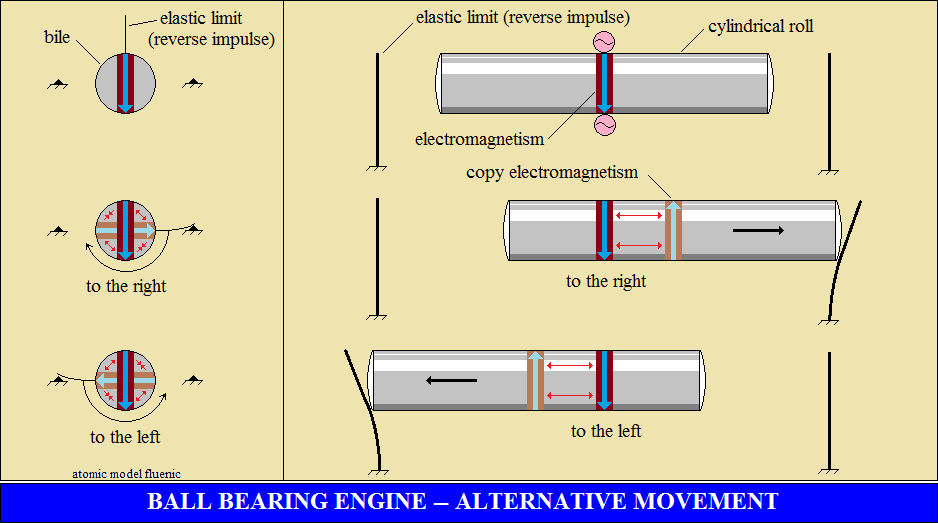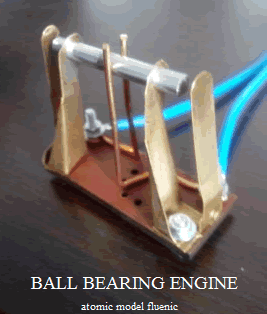Electricity
and magnetism
The ball bearing engine is magical by its simplicity:
An axis on which two ball bearings are fixed, it rotates when an electric
current passes through its.
The motor effect discovered empirically four decades ago turns out to
be incompatible
with electronics theory. It can not be explained scientifically!
Vector interpretation shows how the motor effect occurs simultaneously
in each bile.
In the internal combustion engine, the motor effect occurs successively
in each cylinder.
The motor effect inside bile
The ball bearing engine has two hypotheses, a static hypostasis and a
dynamic hypothesis.
The static hypostasis
The electric current vectorialy interpreted are the polarities of atoms,
oriented by the polarities of the source, just as the magnetism of the
earth orientates the needle of a compass.
Thus, the atoms of the bile direct their electrical polarities
on the direction of the contact points with the source.
The electrical polarities, accompanied by their orthogonal magnetic polarities
,
together produce EM centripetal force, compressing polarities into a continuous
electric wire,
surrounded by their common magnetism.
Two electromagnets were formed in the balls:
The source electromagnet, solid with the contact points of source,
and the electromagnet copied in the steel structure, which is solid with
the bile
Both electromagnets having the same orientation are compressed into one
another
by the centripetal EM force (Ampere's rule), keeping the bile blocked..
This is the static hypothesis, the bearing does not spin (feels with the
hand).
Dynamic hypostasis
Forcing rotating the bile (impulse), the copy detached by shearing, inverts
its polarities,
forming the couples of the forces that produce motor effect (the Ampere
rule).
The motor effect are electromagnetic interactions between the two electromagnets,
fixed and mobile.
Extension
The importance of those described above is to understand
the interactions inside the steel ball produced by external electrical
actions.
An understanding blocked by electronic theory.
We extend the vector interactions analysis from inside the bile, at the
interactions
of a cylindrical roll with the same steel structure.
In theory, the roll rotates as the bile.
Moreover, if the roll receives an axial impulse, the same forces move
the linear roll.
The electromagnet has become a sort of "directional radio antenna".
It does not emit waves, it emits copies of the electromagnet, with damped
oscillations,
which produce linearly move the roll (as Tiolcvschi's stones).
If the roll receives both pulses, axial and circular, the roll will have
a helical motion.
This move reminds of that of a bullet fired from the a gun with grooves
The phenomenon demonstrates the existence of vector interactions within
a solid structure,
that can move the structure, circular, linear, or helical.
The source of the interaction forces being the properties of the vectors.
Experiment
I realized this experimental device, with a steel roll, to observe the
phenomena.
The expectations were partially confirmed, the roll presents the same
EM lock,
oppose to impulse, without continuing the rotation.
The explanation: EM forces are inferior to resistances forces.
The case of ball bearings is determined by the resistances forces,
which are divided by the number of balls and become inferior.
These interactions are universal
Noteworthy, phenomena are demonstrated in solid strata, where resistances
forces are maximal.
In liquid, gaseous and vector space structures, resistant forces are diminished
until extinction.
On the Earth there are liquid, gaseous structures, and radio transmissions.
Electrical discharges can cause phenomena in these structures,
that do not have clear explanations (by electronic theory).
Interactions that produce ball bearings rotation, also produce solar activity!


